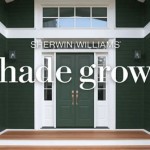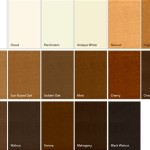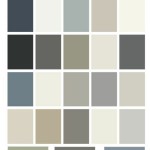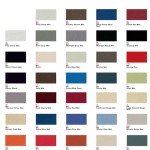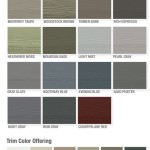What Colour to Paint a Wooden Fence: A Comprehensive Guide
Choosing the right colour to paint a wooden fence is a decision that impacts more than just aesthetics. It influences the overall atmosphere of a garden, complements the landscape, and can even affect the longevity of the fence itself. The selection process should consider factors such as the style of the house, the existing foliage, the desired mood, and practical considerations like sunlight exposure and maintenance.
A well-chosen colour can transform a tired fence into a focal point, seamlessly blend it into the background, or provide a striking contrast with the surrounding environment. This article will explore various colour options, their benefits, and the factors involved in making an informed decision for painting a wooden fence.
Understanding the Impact of Colour on the Garden Environment
Colour psychology plays a significant role in how we perceive our surroundings. Colours can evoke different emotions and create distinct atmospheres. In the context of a garden fence, the choice of colour can dramatically alter the perceived size of the space, enhance the vibrancy of plants, and influence the overall feeling of the outdoor area.
For instance, lighter colours, such as white or pale greys, can make a small garden appear larger and more open by reflecting light. These colours also provide a neutral backdrop that allows the colours of flowers and foliage to stand out. Conversely, darker colours, like deep browns or greens, tend to recede into the background, making them ideal for creating a sense of privacy and allowing the garden's natural elements to take centre stage.
The intensity of the colour is also crucial. Bright, bold colours can add a touch of exuberance and personality, but they can also be overwhelming if not used carefully. Muted or earthy tones, on the other hand, offer a more subtle and calming effect, blending harmoniously with the natural environment.
Consider the orientation of the garden. Fences facing south tend to receive more sunlight, which can cause colours to fade more quickly. Lighter colours, while reflective, may also show dirt and weathering more readily than darker shades. Conversely, fences facing north may benefit from lighter colours to brighten up shady areas.
Exploring Popular Colour Options for Wooden Fences
The range of colours available for painting a wooden fence is vast, but certain options are consistently popular due to their versatility and aesthetic appeal. These options can be broadly categorized into neutral colours, natural wood tones, and bolder, more expressive choices.
Neutral Colours: White is a classic choice that offers a clean, crisp look, particularly well-suited for cottage gardens and modern homes. Grey, in its various shades from light silver to deep charcoal, provides a sophisticated and versatile option that complements a wide range of architectural styles and garden designs. Beige and cream offer warmer neutral alternatives that create a softer and more inviting atmosphere.
Natural Wood Tones: Staining a wooden fence in natural wood tones, such as cedar, redwood, or oak, allows the beauty of the wood grain to shine through. These options create a rustic and organic feel that blends seamlessly with the surrounding landscape. They also tend to be more forgiving of dirt and weathering than lighter colours.
Bolder Colour Choices: For those seeking a more个性化 and expressive look, bolder colours like deep greens, blues, or even reds can be considered. These colours can add a dramatic touch to the garden and create a striking contrast with the foliage. However, it’s important to use these colours judiciously to avoid overwhelming the space.
Before committing to a particular colour, it's advisable to test it on a small, inconspicuous area of the fence to see how it looks in different lighting conditions and alongside the existing plants and structures. This will help ensure that the chosen colour achieves the desired effect.
Factors Influencing Colour Selection
Choosing the right colour for a wooden fence isn’t solely about personal preference; it requires careful consideration of several factors that can impact the overall outcome and longevity of the paint job.
House Style and Architectural Harmony: The colour of the fence should complement the style and colour scheme of the house. A modern home might benefit from a sleek grey or white fence, while a traditional home might look better with a natural wood stain or a classic green. The goal is to create a cohesive and harmonious look that enhances the overall curb appeal of the property.
Surrounding Landscape and Foliage: The colours of the plants, flowers, and other landscape elements should also be taken into account. A fence colour that clashes with the surrounding greenery can create a jarring effect. Consider using a colour wheel to identify complementary colours that will enhance the vibrancy of the plants. For example, a green fence can provide a striking backdrop for flowers with red or purple hues.
Sunlight Exposure and Weather Conditions: Sunlight can fade colours over time, particularly on fences facing south. Therefore, it's advisable to choose fade-resistant paints or stains and consider lighter colours that reflect sunlight. In areas with harsh weather conditions, such as heavy rain or snow, it's important to choose a durable and weather-resistant paint or stain that will protect the wood from damage.
Maintenance and Upkeep: Lighter colours tend to show dirt and weathering more readily than darker colours, requiring more frequent cleaning and repainting. Conversely, darker colours can absorb more heat, which can cause the wood to expand and contract, potentially leading to cracking or peeling. Consider the amount of time and effort you're willing to invest in maintaining the fence when making your colour choice.
Neighbourhood Aesthetics and Regulations: Before painting a fence, it's important to check with the local homeowner's association (HOA) or municipal regulations to ensure that the chosen colour is permitted. Some communities have restrictions on fence colours to maintain a consistent aesthetic throughout the neighbourhood. Also, consider the colours of your neighbours' fences to avoid creating a conflict or an eyesore.
Type of Wood: Different types of wood react differently to paint and stain. Some woods, like cedar and redwood, are naturally resistant to decay and insects and can be left untreated or stained to enhance their natural beauty. Other woods, like pine, require more protection and may benefit from a solid paint colour that provides a barrier against moisture and pests.
In conclusion, selecting the ideal colour for a wooden fence is a multifaceted process that demands careful evaluation. By considering the interplay of colour psychology, architectural style, environmental context, and practical maintenance factors, homeowners can make informed decisions that enhance the beauty, longevity, and overall value of their outdoor spaces.

Fence Paint Colours

The Best Colours For Your Property Fencing

5 Fence Paint Colors To Refresh Your Exterior Curb Appeal Wow 1 Day Painting

Choosing The Right Colour For Your Fence Makeovers

4 Tips For Choosing The Right Fence Color Secure And Rail

Paint Colours For Fence Jims Fencing

Do S And Don Ts For Choosing The Right Fence Colour Maria Killam

Colours For Painting Fence Use Deep To Draw Attention Express Co

Paint Colours For Fence Jims Fencing

Wood Fence Painting And Staining Instructions Tips
Related Posts


